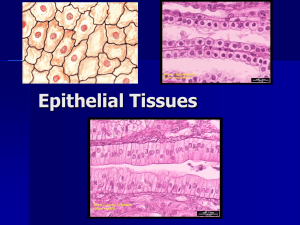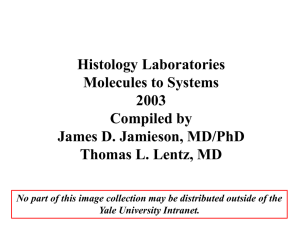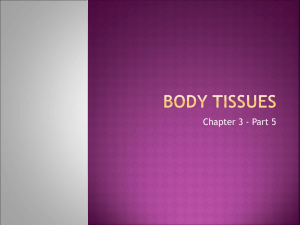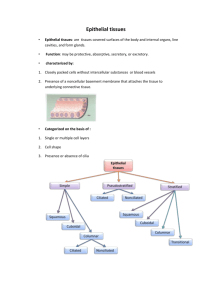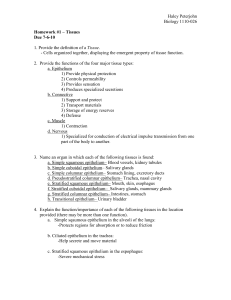EPITHELIUM
advertisement
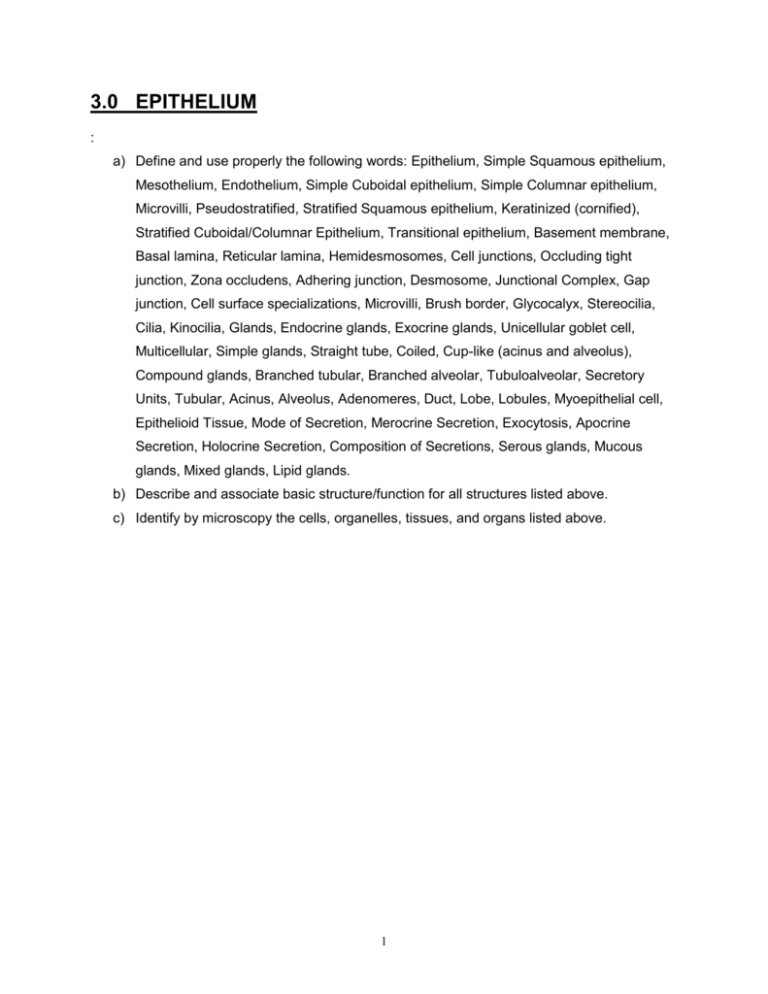
3.0 EPITHELIUM : a) Define and use properly the following words: Epithelium, Simple Squamous epithelium, Mesothelium, Endothelium, Simple Cuboidal epithelium, Simple Columnar epithelium, Microvilli, Pseudostratified, Stratified Squamous epithelium, Keratinized (cornified), Stratified Cuboidal/Columnar Epithelium, Transitional epithelium, Basement membrane, Basal lamina, Reticular lamina, Hemidesmosomes, Cell junctions, Occluding tight junction, Zona occludens, Adhering junction, Desmosome, Junctional Complex, Gap junction, Cell surface specializations, Microvilli, Brush border, Glycocalyx, Stereocilia, Cilia, Kinocilia, Glands, Endocrine glands, Exocrine glands, Unicellular goblet cell, Multicellular, Simple glands, Straight tube, Coiled, Cup-like (acinus and alveolus), Compound glands, Branched tubular, Branched alveolar, Tubuloalveolar, Secretory Units, Tubular, Acinus, Alveolus, Adenomeres, Duct, Lobe, Lobules, Myoepithelial cell, Epithelioid Tissue, Mode of Secretion, Merocrine Secretion, Exocytosis, Apocrine Secretion, Holocrine Secretion, Composition of Secretions, Serous glands, Mucous glands, Mixed glands, Lipid glands. b) Describe and associate basic structure/function for all structures listed above. c) Identify by microscopy the cells, organelles, tissues, and organs listed above. 1 3.0 EPITHELIUM I. BASIC TISSUES A. Tissue is an organized aggregate of cells and cell products that function collectively B. Cells make epithelium; epithelium is a tissue; tissues make organs; organs make systems C. Tissue Types 1. Epithelium a. coverings, sheets of cells in close apposition with a free surface 2. Connective Tissue a. cells holding other tissues together; contains cells separated by extracellular material with specific structural organization. 3. Muscular Tissue a. cells aggregated in bundles with the ability to contract. 4. Nervous Tissue a. cells capable of transmitting electrical impulses from one site to another in the body. II. HOW DO YOU RECOGNIZE EPITHELIUM ? A. Structure 1. sheet of attached cells 2. Cell layer/s 3. Usually nerves do not enter, polarity 4. Basement membrane B. Functions: 1. Protection (Skin); 2. Secretion (glands); 3. Absorption (intestines); 4. Excretion (kidneys); 5. Sensation (retina; olfactory); 6. Transportation (trachea); 7. Reproduction (testis; ovary) 8. Nutrients diffuse III. SIMPLE EPITHELIUM * single layer of cells A. Simple Squamous epithelium 1. MESOTHELIUM = lines the BODY CAVITIES 2. ENDOTHELIUM = lines the BLOOD VESSELS B. Simple Cuboidal epithelium 1. lines SMALL DUCTS or TUBULES 2. FUNCTION = secretion & absorption C. Simple Columnar epithelium + cilia 2 1. height is TALL 2. microvilli are present (INCREASES the SURFACE AREA; e.g., small intestine) 3. cilia are found on some epithelia (e.g., OVIDUCT) D. Pseudostratified + cilia 1. All cells touch the basal lamina, but not all cells reach the free surface. 2. Functions: secretory, transport, environmental monitoring IV. STRATIFIED EPITHELIUM * 2 or more layers .. classified by the top layer A. Stratified Squamous epithelium 1. upper layer has squamous cells 2. protective function in skin, barrier to water, usually no absorptive function 3. Keratinized (cornified) a. protein KERATIN is found in the top layer and serves as a tough coat against abrasions 4. non-keratinized cells a. found lining the buccal cavity B. Stratified Cuboidal & Columnar Epithelium 1. two cell layers 2. found in larger excretory ducts of glands (salivary) V. TRANSITIONAL EPITHELIUM (urinary system only; e.g., urinary bladder) A. Stratified 1. The top layer of cells may vary in shape from a bulge to complete flattening VI. BASEMENT MEMBRANE A. term used in Light microscopy to describe the layer just beneath the epithelium. This layer stains with PAS because it consists of: 1. basal lamina 2. connective tissue components, such as collagen, which contain polysaccharides. B. Basal lamina 1. Seen only at TEM magnification (50-100 nm thick) 2. a layer of type IV collagen plus anchoring protein components 3. synthesized by epithelial cells, serves as a scaffold and filtration barrier C. Reticular lamina 1. connective tissue consisting of very small collagen fibrils 2. associated with the basal lamina area D. Hemidesmosomes 1. Epithelial membrane attachments along the basement membrane 2. Tonofilaments extend from the hemidesomsome into the cytoplasm 3 VII. CELL JUNCTIONS (INTERCELLULAR ADHESIONS) A. Occluding tight junction (zona occludens) 1. membranes between two cells are fused at the surface 2. A Tight junction is formed that prevents the passage of most molecules B. Adhering junction 1. belt-like adhesion beneath the tight junction with actin microfilaments extending inward a. "Terminal Web" consists of actin filaments from the microvilli and the AJ C. Desmosome 1. "spot welds" 2. dense plates along the lateral membranes 3. tonofilaments extend into the cell cytoplasm on both sides D. Junctional Complex = Occluding tight junction + Adhering junction + Desmosome 1. paracellular barrier E. Gap junction 1. spot junctions that have pores which serve as intercellular exchange of ions and other molecules 2. Serve as electrical & chemical pathways VIII. CELL SURFACE SPECIALIZATIONS A. Microvilli 1. cytoplasmic extensions as small fingers containing actin filaments 2. Form a terminal web that extends from the adhering junction 3. Form a "brush border" due to multiple cells with microvilli 4. A glycocalyx is found coating the microvilli as a carbohydrate coat that is pas + 5. stereocilia are not cilia, but instead are long microvilli B. Cilia 1. kinocilia (motile cilia) show active movement a. other cilia may not be motile 2. Structure a. the shaft of the cilium consists of the "axonemal complex" i. made up of microtubules extending from the base to the tip in a 9 doublet + 2 single microtubules formation (9+2) 3. tufts of cilia are found on the cell surface and give a wave-like motion for the movement of substances 4. move fluids and possibly detect chemicals (trachea; cause you to cough) 5. location: respiratory system, oviduct, efferent ducts of testis, spinal cord, and inner ear 6. Clinical significance a. diseases associated with abnormal development or abnormal function of cilia. 4 IX. GLANDS--SPECIALIZED EPITHELIUM A. Classification by the direction of secretions 1. Endocrine glands a. Cell aggregates and cords b. Follicular cells that form an internal chamber for storage of secretions 2. Exocrine glands a. secrete substances into a lumen or onto a surface B. Classification by the number of cells 1. Unicellular goblet cell 2. Multicellular C. Classification as glands with ducts 1. Simple glands a. Straight tube b. Coiled c. Cup-like (acinus and alveolus (larger than an acinus) 2. Compound glands a. Branched tubular b. Branched alveolar c. Tubuloalveolar is a combination D. Classification by the Secretory Units 1. Tubular 2. Acinus (has a small lumen) 3. Alveolus (has a large lumen) 4. Other terms: a. adenomeres = the secretory cells b. duct = the tubule connecting the gland to an epithelial surface c. lobes and lobules (areas separated by connective tissue) d. Myoepithelial cell = contractile cells surrounding glands to aid in the expulsion of secretions e. Epithelioid Tissue = cell aggregates of that are of epithelial origin; the cell have a common structure and secretory function i. e.g., Leydig cells of testis; ii. luteal cells of ovary; iii. adrenal cells; iv. epithelioreticular cells of thymus). v. These cells are also considered endocrine gland cells E. Classification by the mode of Secretion 1. Merocrine Secretion: a. releases by the exocytosis of granules 2. Apocrine Secretion: a. portion of apical cytoplasm is released 3. Holocrine Secretion: the whole cell is released after it dies 5 F. Classification by the composition of Secretions of exocrine glands 1. Serous glands: a. a watery proteinaceous (enzymes) 2. Mucous glands: a. a viscous solution consisting of glycoproteins + polysaccharide 3. Mixed glands: a. a serous + mucous secretion 4. Lipid glands: a. milk; sebum; cerumen that contain an abundance of lipids 6 Epithelial Types and Locations for Reference throughout the Course SIMPLE EPITHELIUM Simple Squamous Stratified Squamous (non-keratinized) 1. 2. 3. 4. 5. 6. 7. lining of celomic cavity (mesothelium) lining of blood vessels (endothelium) Alveolus in lung small ducts of glands Bowman's capsule in kidney lining of inner ear labyrinth Rete testis 1. 2. 3. 4. 5. 6. 7. Vestibular region (nasal) oral cavity Lip Esophagus Anus Cornea & conjunctiva Distal male reproductive system Simple Cuboidal Stratified Cuboidal 1. 2. 3. 4. 5. 6. Secretory ducts (eg. pancreas) Collecting and other tubules of the kidney portions of respiratory system Surface of lens and iris Surface of ovary Transition between Seminiferous tubules & rete testis 7. Pigmented epithelium of retina 1. Ducts of various glands 2. Transition between simple and pseudostratified Stratified Columnar 1. 2. 3. 4. Distal urethra Transition between columnar & stratified Upper respiratory Some ducts of parotid and mandibular salivary glands. 5. Lacrimal sac and duct Simple Columnar 1. 2. 3. 4. 5. 6. Glandular stomach Intestine Gall bladder lining of some secretory ducts Uterus & uterine horns some mid-respiratory areas Transitional 1. Urinary system only (except some regions of conjunctiva) 2. Urinary bladder Pseudostratified 1. Upper respiratory (trachea) 2. Epididymis 3. Ducts of glands at the transition with stratified SPECIALIZED 1. Glands (salivary, pancreas, lacrimal, sebaceous, mammary, adrenal, parathyroid, thyroid, hypothalamus, pituitary, testis, ovary) 2. Myoepithelium (mammary gland, sweat gland, seminiferous tubule) 3. Seminiferous tubule epithelium STRATIFIED EPITHELIUM Stratified Squamous (keratinized) 1. 2. 3. 4. Body surface epidermis Buccal cavity Anal region Ruminant forestomach 7

